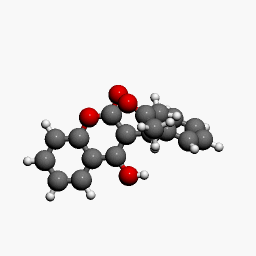Warfarin (injection)
 From Wikidoc - Reading time: 25 min
From Wikidoc - Reading time: 25 min
Editor-In-Chief: C. Michael Gibson, M.S., M.D. [1]; Associate Editor(s)-in-Chief: Turky Alkathery, M.D. [2]
Disclaimer
WikiDoc MAKES NO GUARANTEE OF VALIDITY. WikiDoc is not a professional health care provider, nor is it a suitable replacement for a licensed healthcare provider. WikiDoc is intended to be an educational tool, not a tool for any form of healthcare delivery. The educational content on WikiDoc drug pages is based upon the FDA package insert, National Library of Medicine content and practice guidelines / consensus statements. WikiDoc does not promote the administration of any medication or device that is not consistent with its labeling. Please read our full disclaimer here.
Black Box Warning
|
BLEEDING RISK
See full prescribing information for complete Boxed Warning.
|
Overview
Warfarin (injection) is a vitamin K antagonist that is FDA approved for the treatment of venous thrombosis and its extension, pulmonary embolism and thromboembolic complications associated with atrial fibrillation and/or cardiac valve replacement. There is a Black Box Warning for this drug as shown here. Common adverse reactions include fatal and nonfatal hemorrhage from any tissue or organ.
Adult Indications and Dosage
FDA-Labeled Indications and Dosage (Adult)
Indications
- Warfarin is indicated for:
- Prophylaxis and treatment of venous thrombosis and its extension, pulmonary embolism (PE).
- Prophylaxis and treatment of thromboembolic complications associated with atrial fibrillation (AF) and/or cardiac valve replacement.
- Reduction in the risk of death, recurrent myocardial infarction (MI), and thromboembolic events such as stroke or systemic embolization after myocardial infarction.
- Limitations of Use
- Warfarin has no direct effect on an established thrombus, nor does it reverse ischemic tissue damage. Once a thrombus has occurred, however, the goals of anticoagulant treatment are to prevent further extension of the formed clot and to prevent secondary thromboembolic complications that may result in serious and possibly fatal sequelae.
Dosage
Individualized Dosing
- The dosage and administration of warfarin must be individualized for each patient according to the patient’s INR response to the drug. Adjust the dose based on the patient’s INR and the condition being treated. Consult the latest evidence-based clinical practice guidelines from the American College of Chest Physicians (ACCP) to assist in the determination of the duration and intensity of anticoagulation with warfarin.
Recommended Target INR Ranges and Durations for Individual Indications
- An INR of greater than 4.0 appears to provide no additional therapeutic benefit in most patients and is associated with a higher risk of bleeding.
- Venous Thromboembolism (including deep venous thrombosis [DVT] and PE)
- Adjust the warfarin dose to maintain a target INR of 2.5 (INR range, 2.0-3.0) for all treatment durations. The duration of treatment is based on the indication as follows:
- For patients with a DVT or PE secondary to a transient (reversible) risk factor, treatment with warfarin for 3 months is recommended.
- For patients with an unprovoked DVT or PE, treatment with warfarin is recommended for at least 3 months. After 3 months of therapy, evaluate the risk-benefit ratio of long-term treatment for the individual patient.
- For patients with two episodes of unprovoked DVT or PE, long-term treatment with warfarin is recommended. For a patient receiving long-term anticoagulant treatment, periodically reassess the risk-benefit ratio of continuing such treatment in the individual patient.
- Atrial Fibrillation
- In patients with non-valvular AF that is persistent or paroxysmal and at high risk of stroke (i.e., having any of the following features: prior ischemic stroke, transient ischemic attack, or systemic embolism, or 2 of the following risk factors: age greater than 75 years, moderately or severely impaired left ventricular systolic function and/or heart failure, history of hypertension, or diabetes mellitus), long-term anticoagulation with warfarin is recommended.
- In patients with non-valvular AF that is persistent or paroxysmal and at an intermediate risk of ischemic stroke (i.e., having 1 of the following risk factors: age greater than 75 years, moderately or severely impaired left ventricular systolic function and/or heart failure, history of hypertension, or diabetes mellitus), long-term anticoagulation with warfarin is recommended.
- For patients with AF and mitral stenosis, long-term anticoagulation with warfarin is recommended.
- For patients with AF and prosthetic heart valves, long-term anticoagulation with warfarin is recommended; the target INR may be increased and aspirin added depending on valve type and position, and on patient factors.
- Mechanical and Bioprosthetic Heart Valves
- For patients with a bileaflet mechanical valve or a Medtronic Hall (Minneapolis, MN) tilting disk valve in the aortic position who are in sinus rhythm and without left atrial enlargement, therapy with warfarin to a target INR of 2.5 (range, 2.0-3.0) is recommended.
- For patients with tilting disk valves and bileaflet mechanical valves in the mitral position, therapy with warfarin to a target INR of 3.0 (range, 2.5-3.5) is recommended.
- For patients with caged ball or caged disk valves, therapy with warfarin to a target INR of 3.0 (range, 2.5-3.5) is recommended.
- For patients with a bioprosthetic valve in the mitral position, therapy with warfarin to a target INR of 2.5 (range, 2.0-3.0) for the first 3 months after valve insertion is recommended. If additional risk factors for thromboembolism are present (AF, previous thromboembolism, left ventricular dysfunction), a target INR of 2.5 (range, 2.0-3.0) is recommended.
- For high-risk patients with MI (e.g., those with a large anterior MI, those with significant heart failure, those with intracardiac thrombus visible on transthoracic echocardiography, those with AF, and those with a history of a thromboembolic event), therapy with combined moderate-intensity (INR, 2.0-3.0) warfarin plus low-dose aspirin (≤100 mg/day) for at least 3 months after the MI is recommended.
- Recurrent Systemic Embolism and Other Indications
- Oral anticoagulation therapy with warfarin has not been fully evaluated by clinical trials in patients with valvular disease associated with AF, patients with mitral stenosis, and patients with recurrent systemic embolism of unknown etiology. However, a moderate dose regimen (INR 2.0-3.0) may be used for these patients.
Initial and Maintenance Dosing
- The appropriate initial dosing of warfarin varies widely for different patients. Not all factors responsible for warfarin dose variability are known, and the initial dose is influenced by:
- Clinical factors including age, race, body weight, sex, concomitant medications, and comorbidities
- Genetic factors (CYP2C9 and VKORC1 genotypes).
- Select the initial dose based on the expected maintenance dose, taking into account the above factors. Modify this dose based on consideration of patient-specific clinical factors. Consider lower initial and maintenance doses for elderly and/or debilitated patients and in Asian patients. Routine use of loading doses is not recommended as this practice may increase hemorrhagic and other complications and does not offer more rapid protection against clot formation.
- Individualize the duration of therapy for each patient. In general, anticoagulant therapy should be continued until the danger of thrombosis and embolism has passed.
- Dosing Recommendations without Consideration of Genotype
- If the patient’s CYP2C9 and VKORC1 genotypes are not known, the initial dose of warfarin is usually 2 to 5 mg once daily. Determine each patient’s dosing needs by close monitoring of the INR response and consideration of the indication being treated. Typical maintenance doses are 2 to 10 mg once daily.
- Dosing Recommendations with Consideration of Genotype
- Table 1 displays three ranges of expected maintenance warfarin doses observed in subgroups of patients having different combinations of CYP2C9 and VKORC1 gene variants. If the patient’s CYP2C9 and/or VKORC1 genotype are known, consider these ranges in choosing the initial dose. Patients with CYP2C9 *1/*3, *2/*2, *2/*3, and *3/*3 may require more prolonged time (>2 to 4 weeks) to achieve maximum INR effect for a given dosage regimen than patients without these CYP variants.

Monitoring to Achieve Optimal Anticoagulation
- Warfarin is a narrow therapeutic range (index) drug, and its action may be affected by factors such as other drugs and dietary vitamin K. Therefore, anticoagulation must be carefully monitored during warfarin therapy. Determine the INR daily after the administration of the initial dose until INR results stabilize in the therapeutic range. After stabilization, maintain dosing within the therapeutic range by performing periodic INRs. The frequency of performing INR should be based on the clinical situation but generally acceptable intervals for INR determinations are 1 to 4 weeks. Perform additional INR tests when other warfarin products are interchanged with warfarin, as well as whenever other medications are initiated, discontinued, or taken irregularly. heparin, a common concomitant drug, increases the INR.
- Determinations of whole blood clotting and bleeding times are not effective measures for monitoring of warfarin therapy.
Missed Dose
- The anticoagulant effect of warfarin persists beyond 24 hours. If a patient misses a dose of warfarin at the intended time of day, the patient should take the dose as soon as possible on the same day. The patient should not double the dose the next day to make up for a missed dose.
Intravenous Route of Administration
- The intravenous dose of warfarin is the same as the oral dose. After reconstitution, warfarin for injection should be administered as a slow bolus injection into a peripheral vein over 1 to 2 minutes. Warfarin for injection is not recommended for intramuscular administration.
- Reconstitute the vial with 2.7 mL of Sterile Water for Injection. The resulting yield is 2.5 mL of a 2 mg per mL solution (5 mg total). Parenteral drug products should be inspected visually for particulate matter and discoloration prior to administration. Do not use if particulate matter or discoloration is noted.
- After reconstitution, warfarin for injection is stable for 4 hours at room temperature. It does not contain any antimicrobial preservative and, thus, care must be taken to assure the sterility of the prepared solution. The vial is for single use only, and any unused solution should be discarded.
Treatment During Dentistry and Surgery
- Some dental or surgical procedures may necessitate the interruption or change in the dose of warfarin therapy. Consider the benefits and risks when discontinuing warfarin even for a short period of time. Determine the INR immediately prior to any dental or surgical procedure. In patients undergoing minimally invasive procedures who must be anticoagulated prior to, during, or immediately following these procedures, adjusting the dosage of warfarin to maintain the INR at the low end of the therapeutic range may safely allow for continued anticoagulation.
Conversion From Other Anticoagulants
- Heparin
- Since the full anticoagulant effect of warfarin is not achieved for several days, heparin is preferred for initial rapid anticoagulation. During initial therapy with warfarin, the interference with heparin anticoagulation is of minimal clinical significance. Conversion to warfarin may begin concomitantly with heparin therapy or may be delayed 3 to 6 days. To ensure therapeutic anticoagulation, continue full dose heparin therapy and overlap warfarin therapy with heparin for 4 to 5 days and until warfarin has produced the desired therapeutic response as determined by INR, at which point heparin may be discontinued.
- Warfarin may increase the activated partial thromboplastin time (aPTT) test, even in the absence of heparin. A severe elevation (>50 seconds) in aPTT with an INR in the desired range has been identified as an indication of increased risk of postoperative hemorrhage.
- Other Anticoagulants
- Consult the labeling of other anticoagulants for instructions on conversion to warfarin.
Dosage Forms and Strengths
- Warfarin tablets are single scored with one face imprinted numerically with 1, 2, 2-1/2, 3, 4, 5, 6, 7-1/2, or 10 superimposed and inscribed with “warfarin” and with the opposite face plain.
- Warfarin tablets are supplied in the following strengths:
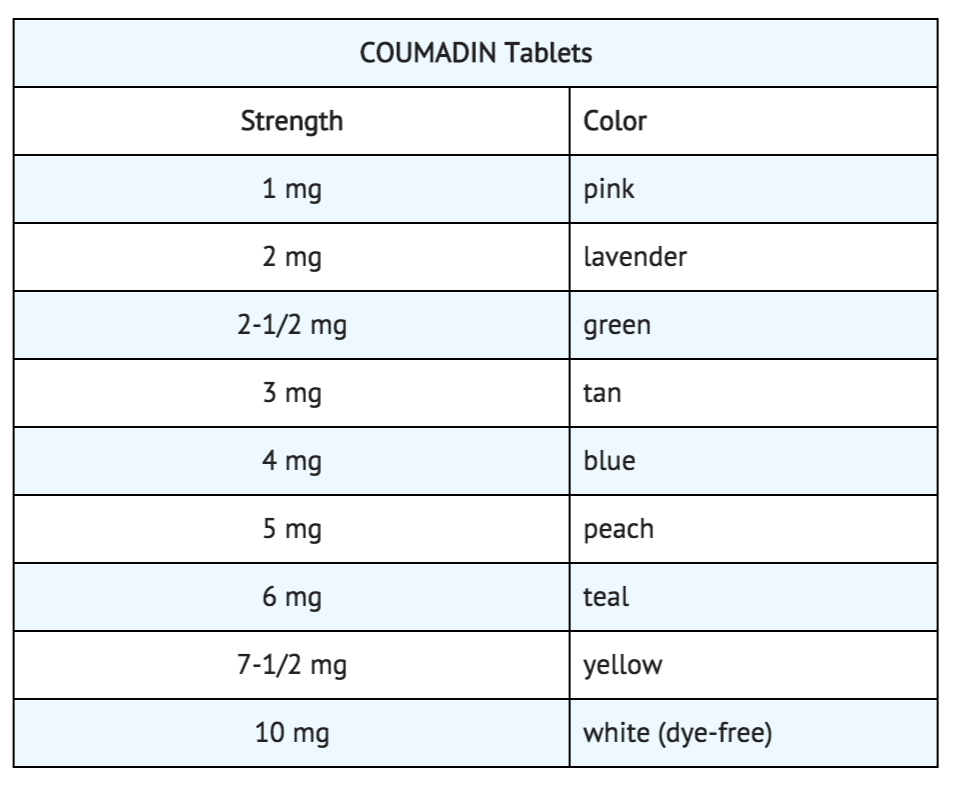
- Warfarin for injection is available in a vial containing 5 mg of lyophilized powder.
Off-Label Use and Dosage (Adult)
Guideline-Supported Use
- Management of Antiphospholipid syndrome. [1]
Non–Guideline-Supported Use
There is limited information regarding Off-Label Non–Guideline-Supported Use of Warfarin (injection) in adult patients.
Pediatric Indications and Dosage
FDA-Labeled Indications and Dosage (Pediatric)
Adequate and well-controlled studies with warfarin have not been conducted in any pediatric population, and the optimum dosing, safety, and efficacy in pediatric patients is unknown. Pediatric use of warfarin is based on adult data and recommendations, and available limited pediatric data from observational studies and patient registries. Pediatric patients administered warfarin should avoid any activity or sport that may result in traumatic injury.
Off-Label Use and Dosage (Pediatric)
Guideline-Supported Use
There is limited information regarding Off-Label Guideline-Supported Use of Warfarin (injection) in pediatric patients.
Non–Guideline-Supported Use
There is limited information regarding Off-Label Non–Guideline-Supported Use of Warfarin (injection) in pediatric patients.
Contraindications
- Pregnancy
- Warfarin is contraindicated in women who are pregnant except in pregnant women with mechanical heart valves, who are at high risk of thromboembolism. Warfarin can cause fetal harm when administered to a pregnant woman. Warfarin exposure during pregnancy causes a recognized pattern of major congenital malformations (warfarin embryopathy and fetotoxicity), fatal fetal hemorrhage, and an increased risk of spontaneous abortion and fetal mortality. If warfarin is used during pregnancy or if the patient becomes pregnant while taking this drug, the patient should be apprised of the potential hazard to a fetus.
- Hemorrhagic tendencies or blood dyscrasias
- Recent or contemplated surgery of the central nervous system or eye, or traumatic surgery resulting in large open surfaces
- bleeding tendencies associated with:
- Active ulceration or overt bleeding of the gastrointestinal, genitourinary, or respiratory tract
- Central nervous system hemorrhage
- Cerebral aneurysms, dissecting aorta
- Pericarditis and pericardial effusions
- Bacterial endocarditis
- Threatened abortion, eclampsia, and preeclampsia
- Unsupervised patients with conditions associated with potential high level of non-compliance
- Spinal puncture and other diagnostic or therapeutic procedures with potential for uncontrollable bleeding
- Hypersensitivity to warfarin or to any other components of this product (e.g., anaphylaxis)
- Major regional or lumbar block anesthesia
- Malignant hypertension
Warnings
|
BLEEDING RISK
See full prescribing information for complete Boxed Warning.
|
Hemorrhage
- Warfarin can cause major or fatal bleeding. Bleeding is more likely to occur within the first month. Risk factors for bleeding include high intensity of anticoagulation (INR >4.0), age greater than or equal to 65, history of highly variable INRs, history of gastrointestinal bleeding, hypertension, cerebrovascular disease, anemia, malignancy, trauma, renal impairment, certain genetic factors, and long duration of warfarin therapy.
- Perform regular monitoring of INR in all treated patients. Those at high risk of bleeding may benefit from more frequent INR monitoring, careful dose adjustment to desired INR, and a shortest duration of therapy appropriate for the clinical condition. However, maintenance of INR in the therapeutic range does not eliminate the risk of bleeding.
- Drugs, dietary changes, and other factors affect INR levels achieved with warfarin therapy. Perform more frequent INR monitoring when starting or stopping other drugs, including botanicals, or when changing dosages of other drugs.
- Instruct patients about prevention measures to minimize risk of bleeding and to report signs and symptoms of bleeding.
Tissue Necrosis
- Necrosis and/or gangrene of skin and other tissues is an uncommon but serious risk (<0.1%). Necrosis may be associated with local thrombosis and usually appears within a few days of the start of warfarin therapy. In severe cases of necrosis, treatment through debridement or amputation of the affected tissue, limb, breast, or penis has been reported.
- Careful clinical evaluation is required to determine whether necrosis is caused by an underlying disease. Although various treatments have been attempted, no treatment for necrosis has been considered uniformly effective. Discontinue warfarin therapy if necrosis occurs. Consider alternative drugs if continued anticoagulation therapy is necessary.
Systemic Atheroemboli and Cholesterol Microemboli
- Anticoagulation therapy with warfarin may enhance the release of atheromatous plaque emboli. Systemic atheroemboli and cholesterol microemboli can present with a variety of signs and symptoms depending on the site of embolization. The most commonly involved visceral organs are the kidneys followed by the pancreas, spleen, and liver. Some cases have progressed to necrosis or death. A distinct syndrome resulting from microemboli to the feet is known as “purple toes syndrome.” Discontinue warfarin therapy if such phenomena are observed. Consider alternative drugs if continued anticoagulation therapy is necessary.
Heparin-Induced Thrombocytopenia
- Do not use warfarin as initial therapy in patients with heparin-induced thrombocytopenia (HIT) and with heparin-induced thrombocytopenia with thrombosis syndrome (HITTS). Cases of limb ischemia, necrosis, and gangrene have occurred in patients with HIT and HITTS when heparin treatment was discontinued and warfarin therapy was started or continued. In some patients, sequelae have included amputation of the involved area and/or death. Treatment with warfarin may be considered after the platelet count has normalized.
Use in Pregnant Women with Mechanical Heart Valves
- Warfarin can cause fetal harm when administered to a pregnant woman. While warfarin is contraindicated during pregnancy, the potential benefits of using warfarin may outweigh the risks for pregnant women with mechanical heart valves at high risk of thromboembolism. In those individual situations, the decision to initiate or continue warfarin should be reviewed with the patient, taking into consideration the specific risks and benefits pertaining to the individual patient’s medical situation, as well as the most current medical guidelines. Warfarin exposure during pregnancy causes a recognized pattern of major congenital malformations (warfarin embryopathy and fetotoxicity), fatal fetal hemorrhage, and an increased risk of spontaneous abortion and fetal mortality. If this drug is used during pregnancy, or if the patient becomes pregnant while taking this drug, the patient should be apprised of the potential hazard to a fetus.
Females of Reproductive Potential
- Warfarin exposure during pregnancy can cause pregnancy loss, birth defects, or fetal death. Discuss pregnancy planning with females of reproductive potential who are on warfarin therapy.
Other Clinical Settings with Increased Risks
- In the following clinical settings, the risks of warfarin therapy may be increased:
- Moderate to severe hepatic impairment
- Infectious diseases or disturbances of intestinal flora (e.g., sprue, antibiotic therapy)
- Use of an indwelling catheter
- Severe to moderate hypertension
- Deficiency in protein C-mediated anticoagulant response: warfarin reduces the synthesis of the naturally occurring anticoagulants, protein C and protein S. Hereditary or acquired deficiencies of protein C or its cofactor, protein S, have been associated with tissue necrosis following warfarin administration. Concomitant anticoagulation therapy with heparin for 5 to 7 days during initiation of therapy with warfarin may minimize the incidence of tissue necrosis in these patients.
- Eye surgery: In cataract surgery, warfarin use was associated with a significant increase in minor complications of sharp needle and local anesthesia block but not associated with potentially sight-threatening operative hemorrhagic complications. As warfarin cessation or reduction may lead to serious thromboembolic complications, the decision to discontinue warfarin before a relatively less invasive and complex eye surgery, such as lens surgery, should be based upon the risks of anticoagulant therapy weighed against the benefits.
- Polycythemia vera
- Vasculitis
- diabetes mellitus
Endogenous Factors Affecting INR
- The following factors may be responsible for increased INR response: diarrhea, hepatic disorders, poor nutritional state, steatorrhea, or vitamin K deficiency.
- The following factors may be responsible for decreased INR response: increased vitamin K intake or hereditary warfarin resistance.
Adverse Reactions
Clinical Trials Experience
- The following serious adverse reactions to warfarin are discussed in greater detail in other sections of the labeling:
- hemorrhage
- Necrosis of skin and other tissues
- Systemic atheroemboli and cholesterol microemboli
- Other adverse reactions to warfarin include:
- Immune system disorders: hypersensitivity/allergic reactions (including urticaria and anaphylactic reactions)
- Vascular disorders: vasculitis
- Hepatobiliary disorders: hepatitis, elevated liver enzymes. Cholestatic hepatitis has been associated with concomitant administration of warfarin and ticlopidine.
- Gastrointestinal disorders: nausea, vomiting, diarrhea, taste perversion, abdominal pain, flatulence, bloating
- Skin disorders: rash, dermatitis (including bullous eruptions), pruritus, alopecia
- Respiratory disorders: tracheal or tracheobronchial calcification
- General disorders: chills
Postmarketing Experience
There is limited information regarding Warfarin (injection) Postmarketing Experience in the drug label.
Drug Interactions
- Drugs may interact with warfarin through pharmacodynamic or pharmacokinetic mechanisms. Pharmacodynamic mechanisms for drug interactions with warfarin are synergism (impaired hemostasis, reduced clotting factor synthesis), competitive antagonism (vitamin K), and alteration of the physiologic control loop for vitamin K metabolism (hereditary resistance). Pharmacokinetic mechanisms for drug interactions with warfarin are mainly enzyme induction, enzyme inhibition, and reduced plasma protein binding. It is important to note that some drugs may interact by more than one mechanism.
- More frequent INR monitoring should be performed when starting or stopping other drugs, including botanicals, or when changing dosages of other drugs, including drugs intended for short-term use (e.g., antibiotics, antifungals, corticosteroids).
- Consult the labeling of all concurrently used drugs to obtain further information about interactions with warfarin or adverse reactions pertaining to bleeding.
CYP450 Interactions
- CYP450 isozymes involved in the metabolism of warfarin include CYP2C9, 2C19, 2C8, 2C18, 1A2, and 3A4. The more potent warfarin S-enantiomer is metabolized by CYP2C9 while the R-enantiomer is metabolized by CYP1A2 and 3A4.
- Inhibitors of CYP2C9, 1A2, and/or 3A4 have the potential to increase the effect (increase INR) of warfarin by increasing the exposure of warfarin.
- Inducers of CYP2C9, 1A2, and/or 3A4 have the potential to decrease the effect (decrease INR) of warfarin by decreasing the exposure of warfarin.
- Examples of inhibitors and inducers of CYP2C9, 1A2, and 3A4 are below in Table 2; however, this list should not be considered all-inclusive. Consult the labeling of all concurrently used drugs to obtain further information about CYP450 interaction potential. The CYP450 inhibition and induction potential should be considered when starting, stopping, or changing dose of concomitant medications. Closely monitor INR if a concomitant drug is a CYP2C9, 1A2, and/or 3A4 inhibitor or inducer.
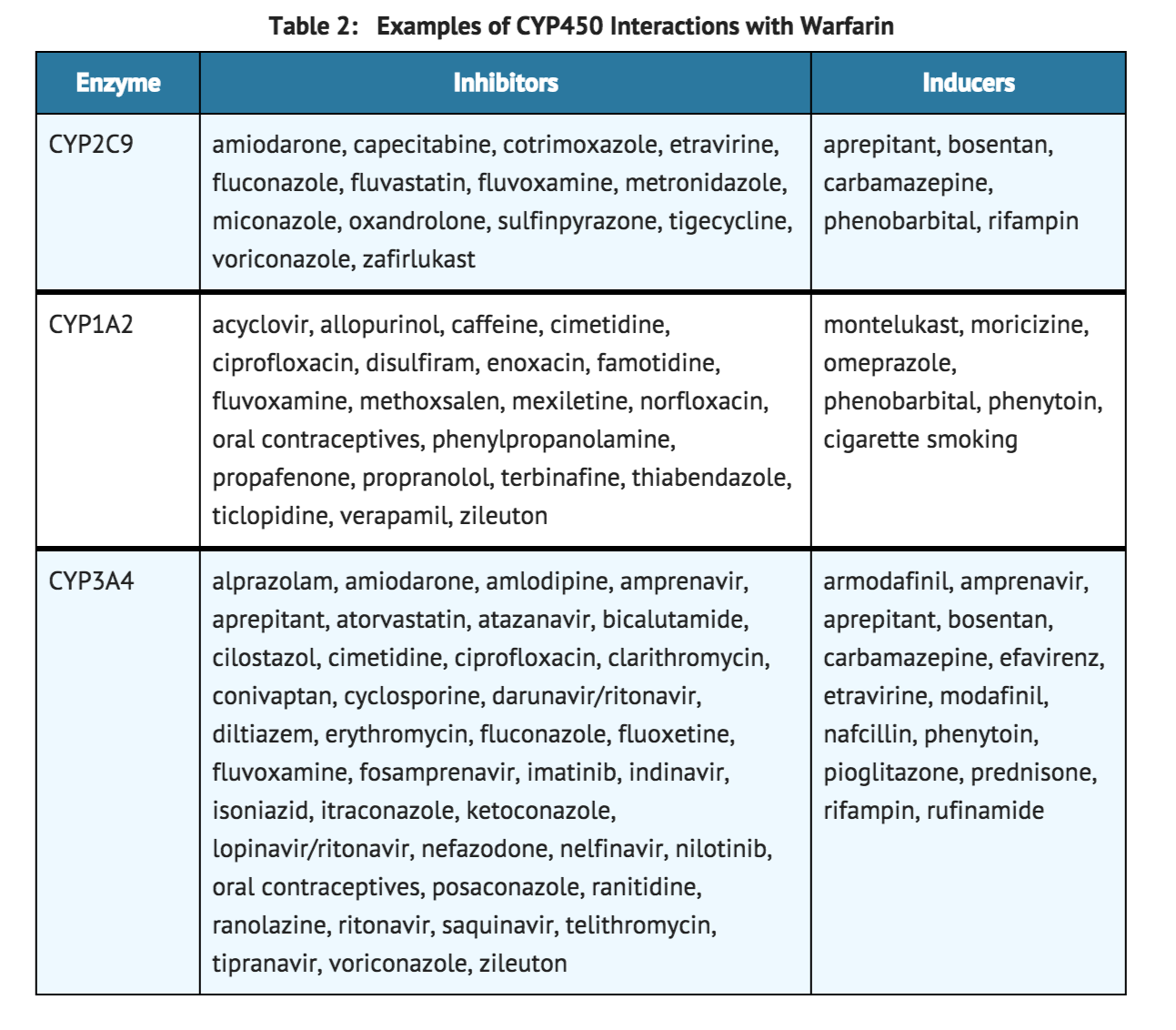
Drugs that Increase Bleeding Risk
- Examples of drugs known to increase the risk of bleeding are presented in Table 3. Because bleeding risk is increased when these drugs are used concomitantly with warfarin, closely monitor patients receiving any such drug with warfarin.
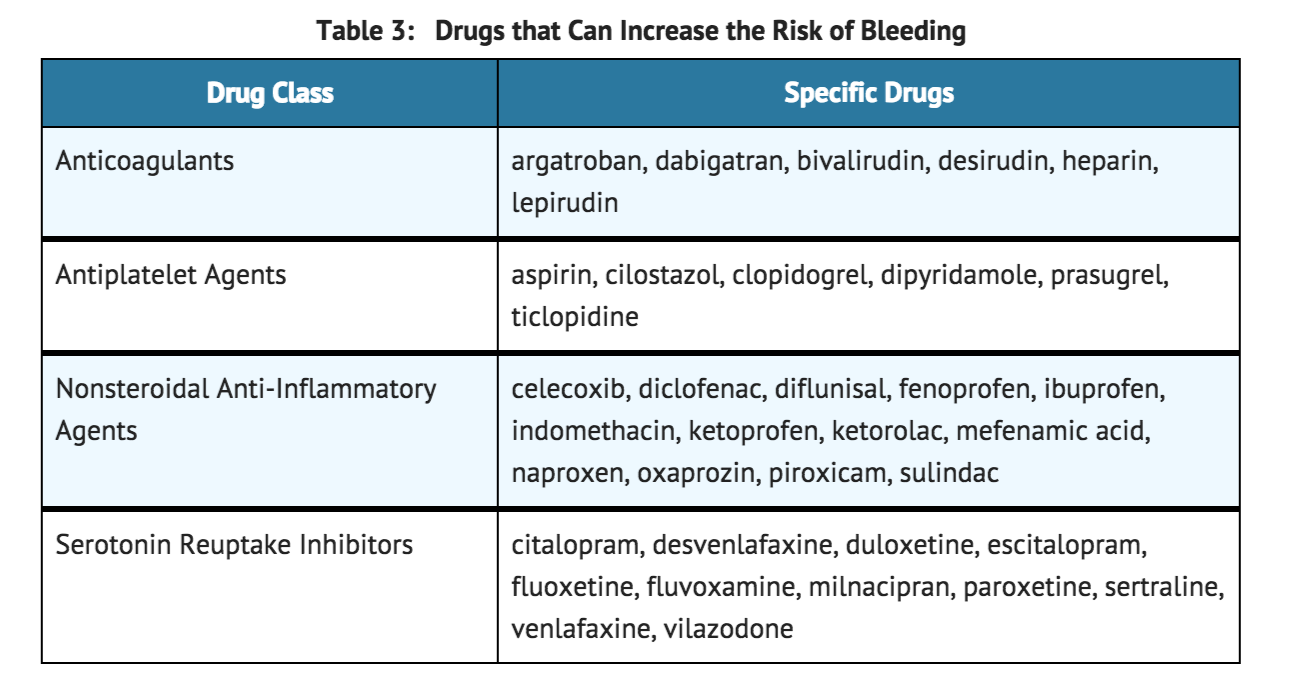
Antibiotics and Antifungals
- There have been reports of changes in INR in patients taking warfarin and antibiotics or antifungals, but clinical pharmacokinetic studies have not shown consistent effects of these agents on plasma concentrations of warfarin.
- Closely monitor INR when starting or stopping any antibiotic or antifungal in patients taking warfarin.
Botanical (Herbal) Products and Foods
- Exercise caution when botanical (herbal) products are taken concomitantly with warfarin. Few adequate, well-controlled studies evaluating the potential for metabolic and/or pharmacologic interactions between botanicals and warfarin exist. Due to a lack of manufacturing standardization with botanical medicinal preparations, the amount of active ingredients may vary. This could further confound the ability to assess potential interactions and effects on anticoagulation.
- Some botanicals may cause bleeding events when taken alone (e.g., garlic and Ginkgo biloba) and may have anticoagulant, antiplatelet, and/or fibrinolytic properties. These effects would be expected to be additive to the anticoagulant effects of warfarin. Conversely, some botanicals may decrease the effects of warfarin (e.g., co-enzyme Q10, St. John’s wort, ginseng). Some botanicals and foods can interact with warfarin through CYP450 interactions (e.g., echinacea, grapefruit juice, ginkgo, goldenseal, St. John’s wort).
- Monitor the patient’s response with additional INR determinations when initiating or discontinuing any botanicals.
Use in Specific Populations
Pregnancy
- Pregnancy Category D for women with mechanical heart valves.
- Pregnancy Category X for other pregnant populations.
- Warfarin is contraindicated in women who are pregnant except in pregnant women with mechanical heart valves, who are at high risk of thromboembolism, and for whom the benefits of warfarin may outweigh the risks. Warfarin can cause fetal harm when administered to a pregnant woman. Warfarin exposure during pregnancy causes a recognized pattern of major congenital malformations (warfarin embryopathy), fetal hemorrhage, and an increased risk of spontaneous abortion and fetal mortality. The reproductive and developmental effects of warfarin have not been evaluated in animals. If this drug is used during pregnancy or if the patient becomes pregnant while taking this drug, the patient should be apprised of the potential hazard to the fetus.
- In humans, warfarin crosses the placenta, and concentrations in fetal plasma approach the maternal values. Exposure to warfarin during the first trimester of pregnancy caused a pattern of congenital malformations in about 5% of exposed offspring. Warfarin embryopathy is characterized by nasal hypoplasia with or without stippled epiphyses (chondrodysplasia punctata) and growth retardation (including low birth weight). Central nervous system and eye abnormalities have also been reported, including dorsal midline dysplasia characterized by agenesis of the corpus callosum, Dandy-Walker malformation, midline cerebellar atrophy, and ventral midline dysplasia characterized by optic atrophy. Mental retardation, blindness, schizencephaly, microcephaly, hydrocephalus, and other adverse pregnancy outcomes have been reported following warfarin exposure during the second and third trimesters of pregnancy.
Pregnancy Category (AUS):
There is no Australian Drug Evaluation Committee (ADEC) guidance on usage of Warfarin (injection) in women who are pregnant.
Labor and Delivery
There is no FDA guidance on use of Warfarin (injection) during labor and delivery.
Nursing Mothers
- Based on published data in 15 nursing mothers, warfarin was not detected in human milk. Among the 15 full-term newborns, 6 nursing infants had documented prothrombin times within the expected range. Prothrombin times were not obtained for the other 9 nursing infants. Monitor breast-feeding infants for bruising or bleeding. Effects in premature infants have not been evaluated. Caution should be exercised when warfarin is administered to a nursing woman.
Pediatric Use
- Adequate and well-controlled studies with warfarin have not been conducted in any pediatric population, and the optimum dosing, safety, and efficacy in pediatric patients is unknown. Pediatric use of warfarin is based on adult data and recommendations, and available limited pediatric data from observational studies and patient registries. Pediatric patients administered warfarin should avoid any activity or sport that may result in traumatic injury.
- The developing hemostatic system in infants and children results in a changing physiology of thrombosis and response to anticoagulants. Dosing of warfarin in the pediatric population varies by patient age, with infants generally having the highest, and adolescents having the lowest milligram per kilogram dose requirements to maintain target INRs. Because of changing warfarin requirements due to age, concomitant medications, diet, and existing medical condition, target INR ranges may be difficult to achieve and maintain in pediatric patients, and more frequent INR determinations are recommended. bleeding rates varied by patient population and clinical care center in pediatric observational studies and patient registries.
- Infants and children receiving vitamin K-supplemented nutrition, including infant formulas, may be resistant to warfarin therapy, while human milk-fed infants may be sensitive to warfarin therapy.
Geriatic Use
- Of the total number of patients receiving warfarin sodium in controlled clinical trials for which data were available for analysis, 1885 patients (24.4%) were 65 years and older, while 185 patients (2.4%) were 75 years and older. No overall differences in effectiveness or safety were observed between these patients and younger patients, but greater sensitivity of some older individuals cannot be ruled out.
- Patients 60 years or older appear to exhibit greater than expected INR response to the anticoagulant effects of warfarin. Warfarin is contraindicated in any unsupervised patient with senility. Observe caution with administration of warfarin to elderly patients in any situation or with any physical condition where added risk of hemorrhage is present. Consider lower initiation and maintenance doses of warfarin in elderly patients.
Gender
There is no FDA guidance on the use of Warfarin (injection) with respect to specific gender populations.
Race
There is no FDA guidance on the use of Warfarin (injection) with respect to specific racial populations.
Renal Impairment
- Renal clearance is considered to be a minor determinant of anticoagulant response to warfarin. No dosage adjustment is necessary for patients with renal impairment.
Hepatic Impairment
- Hepatic impairment can potentiate the response to warfarin through impaired synthesis of clotting factors and decreased metabolism of warfarin. Use caution when using warfarin in these patients.
Females of Reproductive Potential and Males
- Warfarin exposure during pregnancy can cause spontaneous abortion, birth defects, or fetal death. Females of reproductive potential who are candidates for warfarin therapy should be counseled regarding the benefits of therapy and potential reproductive risks. Discuss pregnancy planning with females of reproductive potential who are on warfarin therapy. If the patient becomes pregnant while taking warfarin, she should be apprised of the potential risks to the fetus.
Immunocompromised Patients
There is no FDA guidance one the use of Warfarin (injection) in patients who are immunocompromised.
Administration and Monitoring
Administration
- Intravenous.
Monitoring
- Perform regular monitoring of INR in all treated patients.
- Closely monitor patients receiving any such drug (e.g., other anticoagulants, antiplatelet agents, nonsteroidal anti-inflammatory drugs, serotonin reuptake inhibitors).
- Closely monitor INR when initiating or stopping an antibiotic or antifungal course of therapy.
- Botanical (herbal) products: Some may influence patient response to warfarin necessitating close INR monitoring.
- Use with caution in a nursing woman. Monitor breast-feeding infants for bruising or bleeding.
- Closely monitor INR if a concomitant drug is a CYP2C9, 1A2, and/or 3A4 inhibitor or inducer.
IV Compatibility
There is limited information regarding the compatibility of Warfarin (injection) and IV administrations.
Overdosage
Signs and Symptoms
- Bleeding (e.g., appearance of blood in stools or urine, hematuria, excessive menstrual bleeding, melena, petechiae, excessive bruising or persistent oozing from superficial injuries, unexplained fall in hemoglobin) is a manifestation of excessive anticoagulation.
Treatment
- The treatment of excessive anticoagulation is based on the level of the INR, the presence or absence of bleeding, and clinical circumstances. Reversal of warfarin anticoagulation may be obtained by discontinuing warfarin therapy and, if necessary, by administration of oral or parenteral vitamin K1.
- The use of vitamin K1 reduces response to subsequent warfarin therapy and patients may return to a pretreatment thrombotic status following the rapid reversal of a prolonged INR. Resumption of warfarin administration reverses the effect of vitamin K, and a therapeutic INR can again be obtained by careful dosage adjustment. If rapid re-anticoagulation is indicated, heparin may be preferable for initial therapy.
- Prothrombin complex concentrate (PCC), fresh frozen plasma, or activated Factor VII treatment may be considered if the requirement to reverse the effects of warfarin is urgent. A risk of hepatitis and other viral diseases is associated with the use of blood products; PCC and activated Factor VII are also associated with an increased risk of thrombosis. Therefore, these preparations should be used only in exceptional or life-threatening bleeding episodes secondary to warfarin overdosage.
Pharmacology
Mechanism of Action
- Warfarin acts by inhibiting the synthesis of vitamin K-dependent clotting factors, which include Factors II, VII, IX, and X, and the anticoagulant proteins C and S. Vitamin K is an essential cofactor for the post ribosomal synthesis of the vitamin K-dependent clotting factors. Vitamin K promotes the biosynthesis of γ-carboxyglutamic acid residues in the proteins that are essential for biological activity. Warfarin is thought to interfere with clotting factor synthesis by inhibition of the C1 subunit of vitamin K epoxide reductase (VKORC1) enzyme complex, thereby reducing the regeneration of vitamin K1 epoxide.
Structure
- Warfarin is an anticoagulant that acts by inhibiting vitamin K-dependent coagulation factors. Chemically, it is 3-(α-acetonylbenzyl)-4-hydroxycoumarin and is a racemic mixture of the R- and S-enantiomers. Crystalline warfarin sodium is an isopropanol clathrate. Its empirical formula is C19H15NaO4, and its structural formula is represented by the following:
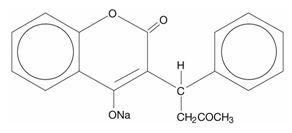
- Warfarin for injection for intravenous use is supplied as a sterile, lyophilized powder, which, after reconstitution with 2.7 mL Sterile Water for Injection, contains:
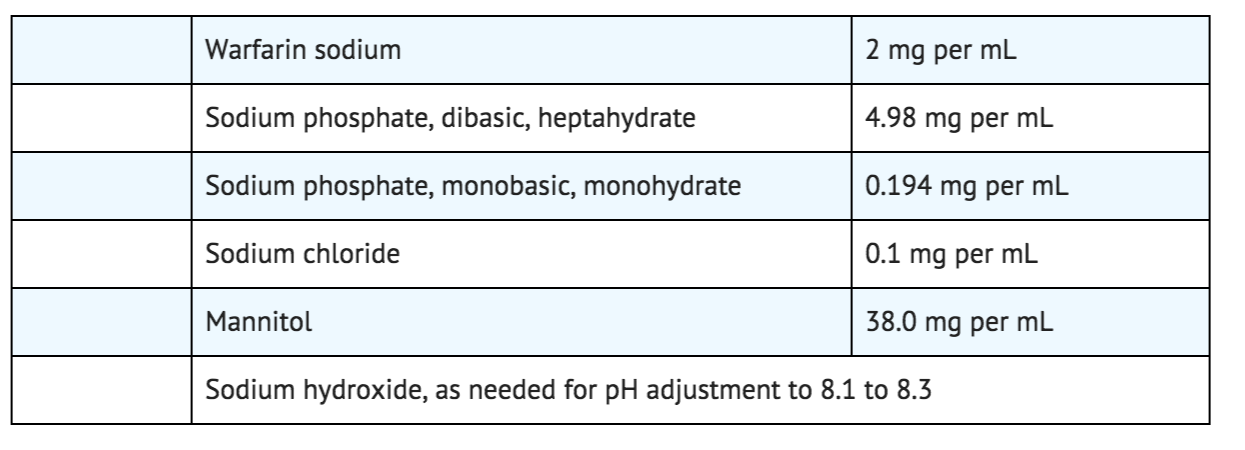
Pharmacodynamics
- An anticoagulation effect generally occurs within 24 hours after warfarin administration. However, peak anticoagulant effect may be delayed 72 to 96 hours. The duration of action of a single dose of racemic warfarin is 2 to 5 days. The effects of warfarin may become more pronounced as effects of daily maintenance doses overlap. This is consistent with the half-lives of the affected vitamin K-dependent clotting factors and anticoagulation proteins: Factor II - 60 hours, VII - 4 to 6 hours, IX - 24 hours, X - 48 to 72 hours, and proteins C and S are approximately 8 hours and 30 hours, respectively.
Pharmacokinetics
- Warfarin is a racemic mixture of the R- and S-enantiomers of warfarin. The S-enantiomer exhibits 2 to 5 times more anticoagulant activity than the R-enantiomer in humans, but generally has a more rapid clearance.
- Absorption
- Warfarin is essentially completely absorbed after oral administration, with peak concentration generally attained within the first 4 hours.
- Distribution
- Warfarin distributes into a relatively small apparent volume of distribution of about 0.14 L/kg. A distribution phase lasting 6 to 12 hours is distinguishable after rapid intravenous or oral administration of an aqueous solution. Approximately 99% of the drug is bound to plasma proteins.
- Metabolism
- The elimination of warfarin is almost entirely by metabolism. Warfarin is stereoselectively metabolized by hepatic cytochrome P-450 (CYP450) microsomal enzymes to inactive hydroxylated metabolites (predominant route) and by reductases to reduced metabolites (warfarin alcohols) with minimal anticoagulant activity. Identified metabolites of warfarin include dehydrowarfarin, two diastereoisomer alcohols, and 4′-, 6-, 7-, 8-, and 10-hydroxywarfarin. The CYP450 isozymes involved in the metabolism of warfarin include CYP2C9, 2C19, 2C8, 2C18, 1A2, and 3A4. CYP2C9, a polymorphic enzyme, is likely to be the principal form of human liver CYP450 that modulates the in vivo anticoagulant activity of warfarin. Patients with one or more variant CYP2C9 alleles have decreased S-warfarin clearance.
- Excretion
- The terminal half-life of warfarin after a single dose is approximately 1 week; however, the effective half-life ranges from 20 to 60 hours, with a mean of about 40 hours. The clearance of R-warfarin is generally half that of S-warfarin, thus as the volumes of distribution are similar, the half-life of R-warfarin is longer than that of S-warfarin. The half-life of R-warfarin ranges from 37 to 89 hours, while that of S-warfarin ranges from 21 to 43 hours. Studies with radiolabeled drug have demonstrated that up to 92% of the orally administered dose is recovered in urine. Very little warfarin is excreted unchanged in urine. Urinary excretion is in the form of metabolites.
- Geriatric Patients
- Patients 60 years or older appear to exhibit greater than expected INR response to the anticoagulant effects of warfarin. The cause of the increased sensitivity to the anticoagulant effects of warfarin in this age group is unknown but may be due to a combination of pharmacokinetic and pharmacodynamic factors. Limited information suggests there is no difference in the clearance of S-warfarin; however, there may be a slight decrease in the clearance of R-warfarin in the elderly as compared to the young. Therefore, as patient age increases, a lower dose of warfarin is usually required to produce a therapeutic level of anticoagulation.
- Asian Patients
- Asian patients may require lower initiation and maintenance doses of warfarin. A non-controlled study of 151 Chinese outpatients stabilized on warfarin for various indications reported a mean daily warfarin requirement of 3.3 ± 1.4 mg to achieve an INR of 2 to 2.5. Patient age was the most important determinant of warfarin requirement in these patients, with a progressively lower warfarin requirement with increasing age.
Nonclinical Toxicology
Carcinogenesis, Mutagenesis, Impairment of Fertility
- Carcinogenicity, mutagenicity, or fertility studies have not been performed with warfarin.
Pharmacogenomics
- CYP2C9 and VKORC1 Polymorphisms
- The S-enantiomer of warfarin is mainly metabolized to 7-hydroxywarfarin by CYP2C9, a polymorphic enzyme. The variant alleles, CYP2C9*2 and CYP2C9*3, result in decreased in vitro CYP2C9 enzymatic 7-hydroxylation of S-warfarin. The frequencies of these alleles in Caucasians are approximately 11% and 7% for CYP2C9*2 and CYP2C9*3, respectively.
- Other CYP2C9 alleles associated with reduced enzymatic activity occur at lower frequencies, including *5, *6, and *11 alleles in populations of African ancestry and *5, *9, and *11 alleles in Caucasians.
- Warfarin reduces the regeneration of vitamin K from vitamin K epoxide in the vitamin K cycle through inhibition of VKOR, a multiprotein enzyme complex. Certain single nucleotide polymorphisms in the VKORC1 gene (e.g., –1639G>A) have been associated with variable warfarin dose requirements. VKORC1 and CYP2C9 gene variants generally explain the largest proportion of known variability in warfarin dose requirements.
- CYP2C9 and VKORC1 genotype information, when available, can assist in selection of the initial dose of warfarin.
Clinical Studies
Atrial Fibrillation
- In five prospective, randomized, controlled clinical trials involving 3711 patients with non-rheumatic AF, warfarin significantly reduced the risk of systemic thromboembolism including stroke (see TABLE 4). The risk reduction ranged from 60% to 86% in all except one trial (CAFA: 45%), which was stopped early due to published positive results from two of these trials. The incidence of major bleeding in these trials ranged from 0.6% to 2.7% (see TABLE 4).

Trials in patients with both AF and mitral stenosis suggest a benefit from anticoagulation with warfarin.
Mechanical and Bioprosthetic Heart Valves
- In a prospective, randomized, open-label, positive-controlled study in 254 patients with mechanical prosthetic heart valves, the thromboembolic-free interval was found to be significantly greater in patients treated with warfarin alone compared with dipyridamole/aspirin-treated patients (p<0.005) and pentoxifylline/aspirin-treated patients (p<0.05). The results of this study are presented in Table 5.
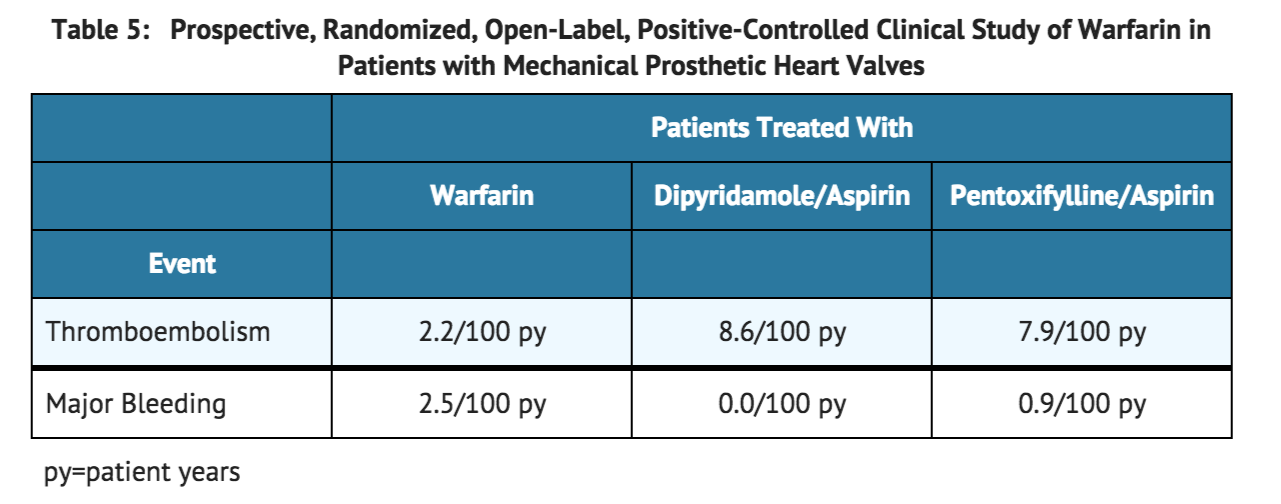
- In a prospective, open-label, clinical study comparing moderate (INR 2.65) vs. high intensity (INR 9.0) warfarin therapies in 258 patients with mechanical prosthetic heart valves, thromboembolism occurred with similar frequency in the two groups (4.0 and 3.7 events per 100 patient years, respectively). Major bleeding was more common in the high intensity group. The results of this study are presented in Table 6.

- In a randomized trial in 210 patients comparing two intensities of warfarin therapy (INR 2.0-2.25 vs. INR 2.5-4.0) for a three-month period following tissue heart valve replacement, thromboembolism occurred with similar frequency in the two groups (major embolic events 2.0% vs. 1.9%, respectively, and minor embolic events 10.8% vs. 10.2%, respectively). Major hemorrhages occurred in 4.6% of patients in the higher intensity INR group compared to zero in the lower intensity INR group.
Myocardial Infarction
- WARIS (The Warfarin Re-Infarction Study) was a double-blind, randomized study of 1214 patients 2 to 4 weeks post-infarction treated with warfarin to a target INR of 2.8 to 4.8. The primary endpoint was a composite of total mortality and recurrent infarction. A secondary endpoint of cerebrovascular events was assessed. Mean follow-up of the patients was 37 months. The results for each endpoint separately, including an analysis of vascular death, are provided in Table 7.
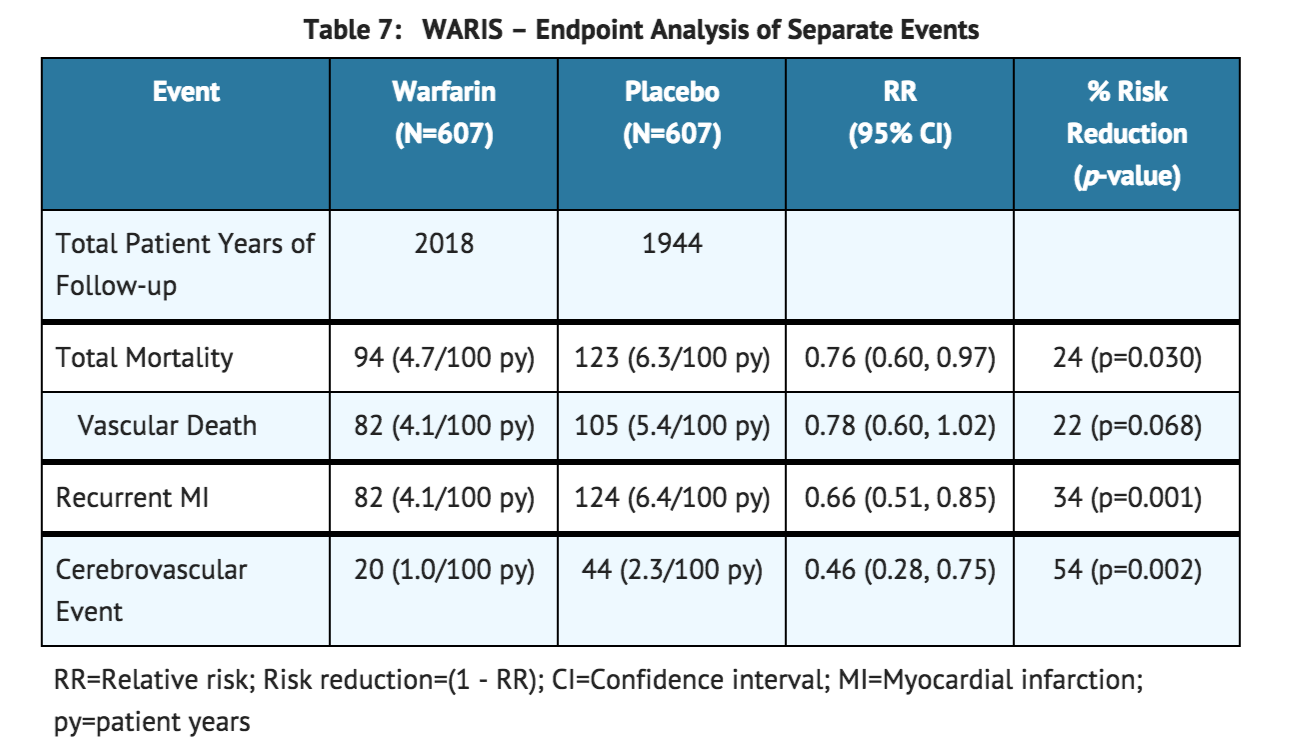
- WARIS II (The Warfarin, aspirin, Re-Infarction Study) was an open-label, randomized study of 3630 patients hospitalized for acute myocardial infarction treated with warfarin to a target INR 2.8 to 4.2, aspirin 160 mg per day, or warfarin to a target INR 2.0 to 2.5 plus aspirin 75 mg per day prior to hospital discharge. The primary endpoint was a composite of death, nonfatal reinfarction, or thromboembolic stroke. The mean duration of observation was approximately 4 years. The results for WARIS II are provided in Table 8.
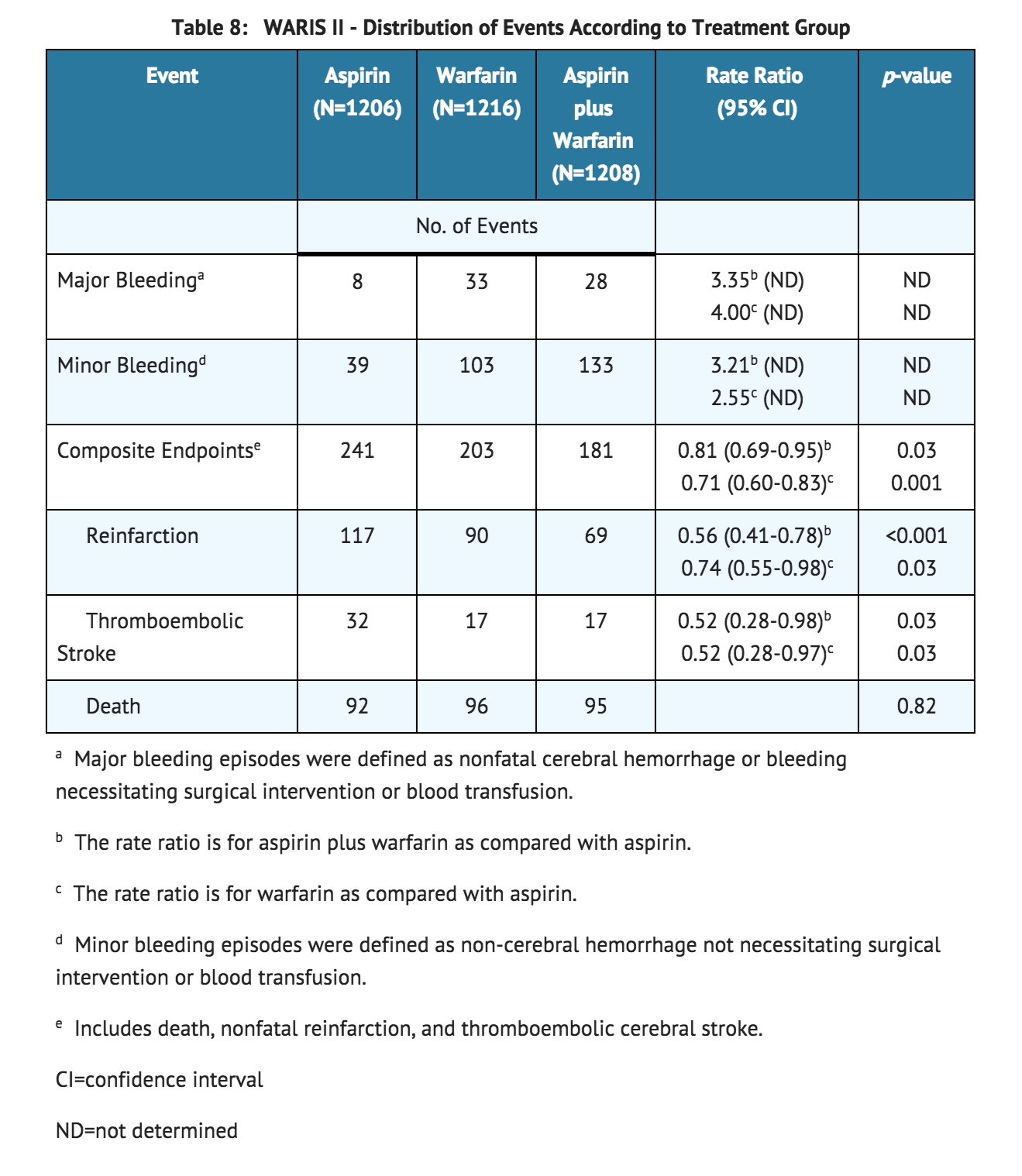
- There were approximately four times as many major bleeding episodes in the two groups receiving warfarin than in the group receiving aspirin alone. Major bleeding episodes were not more frequent among patients receiving aspirin plus warfarin than among those receiving warfarin alone, but the incidence of minor bleeding episodes was higher in the combined therapy group.
How Supplied
- Warfarin for injection vials yield 5 mg of warfarin after reconstitution with 2.7 mL of Sterile Water for Injection (maximum yield is 2.5 mL of a 2 mg/mL solution). Net content of vial is 5.4 mg lyophilized powder.
- 5-mg vial (box of 6) NDC 0590-0324-35
Storage
- Protect from light. Keep vial in box until used. Store at controlled room temperature (59°-86°F, 15°-30°C).
- After reconstitution, store at controlled room temperature (59°-86°F, 15°-30°C) and use within 4 hours. Do not refrigerate. Discard any unused solution.
Images
Drug Images
{{#ask: Page Name::Warfarin (injection) |?Pill Name |?Drug Name |?Pill Ingred |?Pill Imprint |?Pill Dosage |?Pill Color |?Pill Shape |?Pill Size (mm) |?Pill Scoring |?NDC |?Drug Author |format=template |template=DrugPageImages |mainlabel=- |sort=Pill Name }}
Package and Label Display Panel

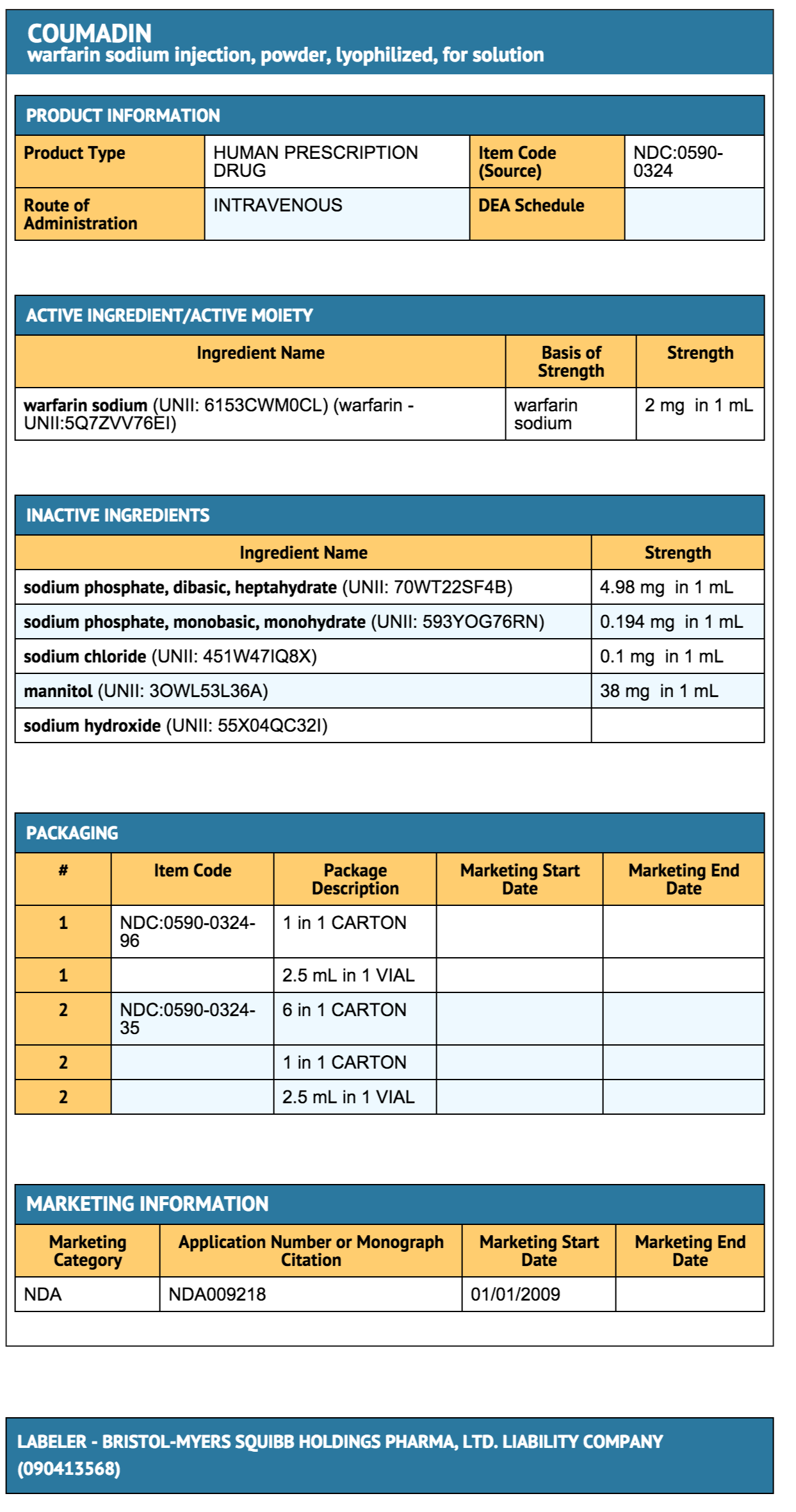
{{#ask: Label Page::Warfarin (injection) |?Label Name |format=template |template=DrugLabelImages |mainlabel=- |sort=Label Page }}
Patient Counseling Information
- Advise patients to:
- Tell their physician if they fall often as this may increase their risk for complications.
- Strictly adhere to the prescribed dosage schedule. Do not take or discontinue any other drug, including salicylates (e.g., aspirin and topical analgesics), other over-the-counter drugs, and botanical (herbal) products except on advice of your physician.
- Notify their physician immediately if any unusual bleeding or symptoms occur. Signs and symptoms of bleeding include: pain, swelling or discomfort, prolonged bleeding from cuts, increased menstrual flow or vaginal bleeding, nosebleeds, bleeding of gums from brushing, unusual bleeding or bruising, red or dark brown urine, red or tar black stools, headache, dizziness, or weakness.
- Contact their doctor
- immediately if they think they are pregnant
- to discuss pregnancy planning
- if they are considering breast-feeding
- Avoid any activity or sport that may result in traumatic injury.
- Obtain prothrombin time tests and make regular visits to their physician or clinic to monitor therapy.
- Carry identification stating that they are taking COUMADIN.
- If the prescribed dose of COUMADIN is missed, take the dose as soon as possible on the same day but do not take a double dose of COUMADIN the next day to make up for missed doses.
- Eat a normal, balanced diet to maintain a consistent intake of vitamin K. Avoid drastic changes in dietary habits, such as eating large amounts of leafy, green vegetables.
- Contact their physician to report any serious illness, such as severe diarrhea, infection, or fever.
- Be aware that if therapy with COUMADIN is discontinued, the anticoagulant effects of COUMADIN may persist for about 2 to 5 days.

Precautions with Alcohol
Alcohol-Warfarin (injection) interaction has not been established. Talk to your doctor about the effects of taking alcohol with this medication.
Brand Names
- COUMADIN®[4]
Look-Alike Drug Names
There is limited information regarding Look-Alike Drug Names.
Drug Shortage Status
Price
References
The contents of this FDA label are provided by the National Library of Medicine.
- ↑ Khamashta MA, Cuadrado MJ, Mujic F, Taub NA, Hunt BJ, Hughes GR (1995). "The management of thrombosis in the antiphospholipid-antibody syndrome". N Engl J Med. 332 (15): 993–7. doi:10.1056/NEJM199504133321504. PMID 7885428.
- ↑ Holford, NH (December 1986). "Clinical Pharmacokinetics and Pharmacodynamics of Warfarin Understanding the Dose-Effect Relationship". Clinical Pharamacokinetics. Springer International Publishing. 11 (6): 483–504. doi:10.2165/00003088-198611060-00005. PMID 3542339. line feed character in
|title=at position 48 (help) - ↑ 3.0 3.1 3.2 3.3 "PRODUCT INFORMATION Coumadin" (PDF). TGA eBusiness Services. Aspen Pharma Pty Ltd. 19 January 2010. Retrieved 11 December 2013.
- ↑ "COUMADIN- warfarin sodium injection, powder, lyophilized, for solution".
 KSF
KSF
